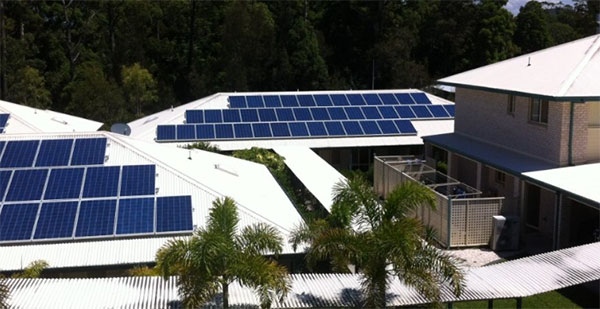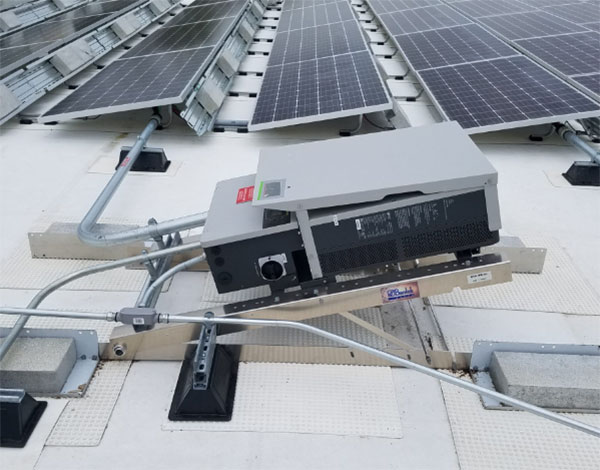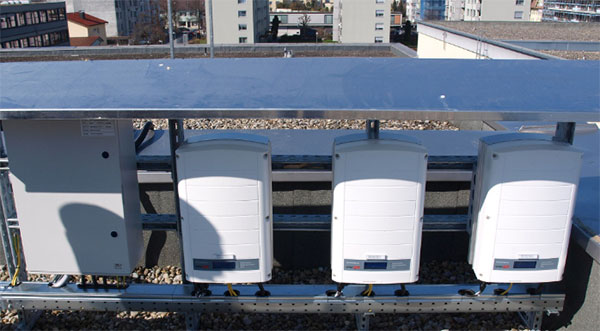Description
Solar inverters do not require shading but benefit from cooler, ventilated locations to enhance efficiency and lifespan.

Optimal Placement for Solar Inverters
The
optimal placement of solar inverters is crucial for maximizing the efficiency and lifespan of a solar power system. Solar inverters convert the direct current (DC) output of a solar panel into alternating current (AC) that can be fed into a commercial electrical grid or used by a local, off-grid electrical network.
Understanding Solar Inverter Functionality
Solar inverters play a key role in solar energy systems by ensuring that the power generated by solar panels can be used by standard electrical appliances. They also provide system analytics, including fault detection and system management. The efficiency of a solar inverter typically ranges from 95% to 98%, making it essential to select an inverter that offers high efficiency to maximize energy output.
Factors Influencing Solar Inverter Placement
- Temperature and Cooling: Solar inverters operate efficiently within a specific temperature range, usually between -20°C and 60°C. Placing inverters in the shade can prevent overheating, ensuring they operate within the optimal temperature range. Overheating can reduce the efficiency and lifespan of the inverter.
- Accessibility for Maintenance: Easy access to the inverter for regular maintenance checks and repairs is essential. An inaccessible inverter can increase the cost and time required for maintenance.
- Distance from Solar Panels: The distance between the solar panels and the inverter affects energy loss. A shorter cable length reduces resistance and potential energy loss, enhancing system efficiency.
- Protection from Elements: While solar inverters are designed to withstand environmental conditions, excessive exposure to water, dust, or direct sunlight can degrade their performance and durability. Proper housing or placement can mitigate these risks.

Effects of Temperature on Solar Inverter Performance
Understanding how temperature impacts solar inverter performance is crucial for maximizing efficiency and lifespan. Solar inverters convert direct current (DC) from solar panels into alternating current (AC) for use in homes and businesses. However, their efficiency and durability can be significantly affected by thermal conditions.
Heat Impact on Inverter Efficiency
High temperatures reduce inverter efficiency. Most solar inverters operate optimally within a specific temperature range, typically between 15°C and 25°C. As the ambient temperature increases beyond this range, the efficiency of the inverter decreases. For instance, an inverter's efficiency might drop from 98% to 95% when the temperature rises from 25°C to 40°C. This efficiency loss can result in a significant decrease in the overall power output of the solar energy system.
Inverter components are sensitive to heat. The electronic components within an inverter, such as capacitors and semiconductors, are particularly sensitive to high temperatures. Extended exposure to high temperatures can accelerate wear and reduce the lifespan of these components. For example, the expected lifespan of an inverter can decrease from 20 years at an average temperature of 25°C to just 10 years at an average temperature of 50°C.
Managing Thermal Conditions for Inverters
Strategic placement is key. To mitigate the effects of heat, it is important to place inverters in shaded or ventilated areas. Avoiding direct sunlight can help maintain the inverter within its optimal temperature range, enhancing both efficiency and lifespan.
Active cooling systems can protect inverters. For locations with high ambient temperatures, incorporating active cooling systems, such as fans or air conditioning units, can help maintain the inverter at an optimal operating temperature. While this introduces additional costs, it can be a worthwhile investment to preserve inverter efficiency and longevity.
Regular maintenance ensures optimal performance. Dust and debris can insulate an inverter, trapping heat. Regular cleaning as part of maintenance can help prevent overheating and maintain efficiency.

Shading and Solar Inverter Efficiency
The Role of Shading in Inverter Operation
Shading on solar panels significantly affects the performance of solar inverters.
Solar inverters convert the direct current (DC) output into alternating current (AC) for home or commercial use. The efficiency of this conversion process is crucial for maximizing the output of a solar power system. Shading can lead to a decrease in solar panel output by as much as 25%, which directly impacts the inverter's efficiency.
Inverters rely on the consistent output from solar panels to operate optimally. When shading occurs, it causes a reduction in voltage output from the affected panels. Modern inverters are designed to mitigate these effects through maximum power point tracking (MPPT). MPPT algorithms allow the inverter to adjust its parameters to find the maximum power output despite the reduced input due to shading.
Pros and Cons of Solar Inverter Shading
Advantages of Proper Inverter Placement:
- Enhanced Longevity: By installing solar inverters in shaded areas, their exposure to high temperatures is reduced, potentially extending their operational lifespan. Solar inverters, when operating within their optimal temperature range, can have a lifespan of over 20 years.
- Improved Efficiency: Keeping solar inverters cool can help maintain their efficiency. A study showed that for every 1°C increase in temperature, an inverter's efficiency can drop by 0.5%. Therefore, shading can play a crucial role in maximizing energy conversion efficiency.
Disadvantages of Inverter Shading:
- Space and Installation Limitations: Finding an ideal shaded location that is also close to the solar panels can be challenging. This might lead to longer cable runs, which can increase power losses and installation costs. The cost impact can vary, but typically, longer cable runs can increase installation costs by up to 10%.
- Maintenance Accessibility: Placing inverters in shaded or less accessible areas might complicate maintenance and monitoring efforts. It's essential to balance the benefits of shading with the need for easy access.
Cost Considerations:
The cost of a solar inverter can range from $1,000 to $2,000 for residential systems, and the decision to place it in a shaded area should also consider the potential need for additional protective measures against moisture and debris, which can add to the overall cost.

Installation Guidelines for Solar Inverters
Best Practices for Inverter Installation
Selecting the Right Location: The placement of a solar inverter is crucial for its efficiency and longevity. It should be installed in a well-ventilated area to prevent overheating. Direct sunlight can significantly increase the operational temperature, leading to efficiency losses. For instance, an inverter's efficiency can decrease by 0.5% for every 1°C increase in temperature above its optimal range. Ideally, the inverter should be placed in a shaded or indoor environment to avoid direct exposure to sunlight.
Ensuring Accessibility: While shading is vital, accessibility for maintenance and monitoring should not be compromised. The inverter should be installed at a height where it is easily reachable for any required inspections or interventions. This consideration balances operational efficiency with long-term maintenance needs.
Cable Management: The distance between solar panels and the inverter should be minimized to reduce voltage drop and power loss over the cables. Power loss in cables can range from 1% to 3% depending on the length and thickness of the cables used. Using thicker cables can mitigate this loss but will increase the initial installation cost.
Environmental Considerations for Inverter Placement
Temperature Regulation: The operational temperature range for most solar inverters is between -20°C and 60°C. Installing the inverter in a location that remains within this range throughout the year is critical. External cooling or shading structures can be employed to maintain optimal temperatures, especially in areas with high ambient temperatures.
Protection from Elements: Inverters should be protected from environmental elements like rain, snow, and excessive dust. While outdoor-rated inverters are designed to withstand such conditions, additional protective measures like installing the inverter under an overhang or within a protective enclosure can extend its lifespan and maintain its efficiency.
Compliance with Local Regulations: It is essential to adhere to local building codes and electrical standards when installing a solar inverter. This includes clearance around the inverter for ventilation, height off the ground, and proximity to other electrical equipment. Failure to comply with these regulations can lead to safety hazards and may affect the system's eligibility for certain incentives or rebates.
Cost and Efficiency Trade-offs: The cost of a residential solar inverter ranges from $1,000 to $2,000, with the total installation cost being influenced by the complexity of the installation, including cable length and protective measures. Investing in an optimal installation can enhance system performance, reduce maintenance costs, and increase the inverter's lifespan, offering better returns on investment over time.

Maintenance and Performance Monitoring
Routine Maintenance for Optimal Inverter Performance
Monthly Visual Inspections: Regularly inspect the solar inverter for any signs of damage or wear. Look for loose connections, damaged cables, or signs of overheating. Ensuring that the inverter's ventilation system is not obstructed is crucial for preventing overheating. An obstructed ventilation system can lead to a 10% loss in efficiency due to increased operating temperatures.
Annual Professional Check-ups: Have a certified technician perform an annual inspection of the inverter. This check-up should include testing the inverter's efficiency, which should remain above 95% for most models. If efficiency drops below this threshold, it may indicate internal issues that require repair or replacement. The cost for professional maintenance services can range from $150 to $300, depending on the complexity of the system and the specific services provided.
Cleaning Procedures: Dust and debris can accumulate on the inverter, impacting its ability to cool down properly. Cleaning the exterior of the inverter and ensuring its fans or ventilation slots are clear can prevent thermal overload. In areas with high dust levels, more frequent cleaning may be necessary to maintain optimal performance.
Monitoring Systems for Inverter Health and Efficiency
Real-Time Monitoring Tools: Advanced solar inverters come equipped with real-time monitoring capabilities that allow homeowners to track the system's performance. These tools can alert users to efficiency drops, potential malfunctions, or maintenance needs. For example, monitoring systems can detect a sudden drop in power output, which might indicate a problem with the solar panels or the inverter itself.
Remote Diagnostics: Many modern inverters offer remote diagnostic features, enabling technicians to assess the inverter's condition without needing to visit the site physically. This technology can save significant time and money by pinpointing issues quickly and accurately, potentially avoiding the cost of unnecessary site visits.
Software Updates: Keeping the inverter's firmware updated is crucial for maintaining its efficiency and compatibility with monitoring systems. Manufacturers often release software updates to improve performance, add new features, or address security vulnerabilities. These updates can often be applied remotely and are typically free of charge.
Performance Metrics Tracking: Monitor key performance indicators such as AC output power, DC input from the solar panels, and overall efficiency. Noticing trends over time can help preemptively identify when maintenance or repairs might be needed. For instance, a gradual decrease in efficiency might indicate aging components, while a sudden drop could signal a malfunction or damage.

Case Studies: Solar Inverter Placement and Efficiency
Analysis of Inverter Placement in Diverse Environments
Case Study 1: Residential Installation in a Temperate Climate
In this case, a 5 kW solar inverter was installed in a shaded area on the north side of a home in a temperate climate region.
The inverter's efficiency was maintained at an average of 98% throughout the year. The shaded placement contributed to keeping the inverter's operating temperature within the optimal range, despite seasonal temperature fluctuations. The cost of the inverter and installation totaled $2,000, with a payback period of 5 years due to enhanced efficiency and reduced energy bills.
Key Lesson: Shaded placement in temperate climates can significantly enhance inverter efficiency and longevity, making it a cost-effective strategy over the long term.
Case Study 2: Commercial Installation in a Tropical Climate
A commercial solar project involved the installation of a 50 kW inverter system on the roof of a building in a tropical climate. Due to the high ambient temperatures and direct sunlight exposure, the inverters were equipped with additional cooling systems.
The cooling systems increased the overall cost by 15% but prevented efficiency losses that could have exceeded 10% during peak temperatures. The system's enhanced cooling maintained inverter efficiency above 95%, crucial for the high energy demands of the commercial building.
Key Lesson: In hot climates, investing in additional cooling solutions for inverters can prevent significant efficiency losses, offsetting the initial higher investment through improved performance.
Lessons Learned from Real-World Installations
Lesson 1: Importance of Environmental Considerations
Environmental factors such as temperature, humidity, and sunlight exposure play a crucial role in determining the optimal placement of solar inverters. Installations in different climates have shown that adaptability in placement and protection strategies is key to maintaining high efficiency and prolonging inverter lifespan.
Lesson 2: Balancing Cost and Efficiency
The initial cost of solar inverter installation and any additional protective measures must be balanced with the potential efficiency gains. While additional protections, such as cooling systems or shaded placements, can increase upfront costs, they often lead to longer-term savings and improved system performance.
Lesson 3: Ongoing Monitoring and Maintenance
Continuous monitoring and regular maintenance are essential for sustaining inverter efficiency. Case studies highlight the value of real-time monitoring systems in identifying performance issues early and the importance of routine maintenance in preventing efficiency losses over time.
Lesson 4: Learning from Installation Challenges
Challenges faced during installations, from dealing with space constraints to managing environmental impacts, offer valuable lessons for future projects. Each installation provides insights into optimizing inverter placement and protection for different settings and climates.





